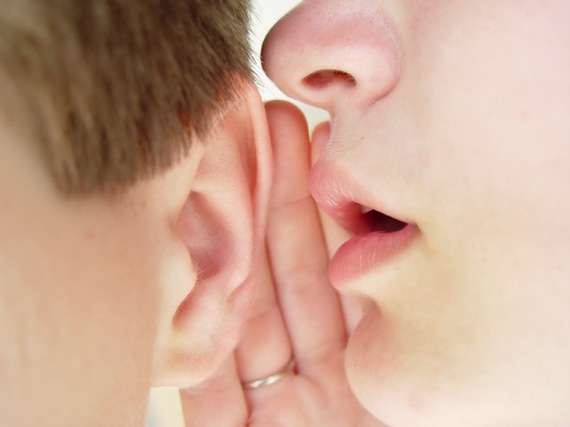A man once told me that he could tell I was an FBI agent by my body language. He said that I walked like I had someone important to meet. He stood up the moment I entered the room and held out his hand in a greeting.
Many people think I’m Asian when they hear my last name, Quy. Actually, it’s French Huguenot. I knew what the man I was meeting looked like because I had his driver’s license photo. How could he be so sure I was the FBI agent he was waiting to meet simply by my walk?
As a business leader and entrepreneur, the more you understand how your body language influences the people around you, the more effectively you can present your ideas with a stronger impact.
Our walk is one of the least analyzed aspects of body language, but as it turns out, our gait is often our first golden opportunity to impress others—or not. Depending how much we understand the messages were are subconsciously conveying, our walk speaks volumes as we walk down an office corridor or into a board meeting.
Here are 5 things a person’s walk projects about their confidence, credibility, and charisma. It—
1. HELPS US EVALUATE STRANGERS
Our early ancestors relied upon their ability to recognize people from a distance. They could see a lone figure on the horizon and determine whether they were friend or foe. Now, we’re more apt to recognize the car a person is driving.
Our ability to receive messages about other people by their body language, however, has not gone away. It’s an innate skill we were all born with.
TIP: These innate skills are often stored in our subconscious. To awaken them, take the time to observe people’s gait when you’re at an airport or music concert. You may not have the opportunity to tap them on the shoulder to determine if you’ve made the right assumption, but over time you’ll become more skillful in accurately interpreting what is going on with them based on their walk and other body language.
2. CONVEYS IMPORTANCE
We convey a lot of information through body language, but it’s easy to forget that our walk is sending a message as powerful as any other gesture. If we’re rushed, or deep in thought, we walk differently. I asked the man I was meeting to share with me what it was that tipped him off, he said, “You walked with an inordinate amount of confidence—quickly, like a person who values her time and the time of others.”
In other words, he could tell by my gait that I was serious and arriving for a business meeting.
People who shuffle along, hug themselves, and keep their head down often lack self-confidence.
TIP: Do not be that person! Walk with alertness and purpose, and keep your shoulders back and head held high. When you do, you are signaling to the world that you have an important place to be and an important task to accomplish.
3. COMMUNICATES OUR THOUGHTS
Recollect a time when you were at a store waiting in a long line to make your purchase. The clerk is slow. You look around and see the other employees also moving at a slow pace. They give the impression of dull minds that have no concern for others. Do you look forward to a return visit? People who give the impression that they don’t care will not be treated the same as those who communicate that they are both eager and capable.
For example, soldiers use forceful body language in marches when they use an exaggerated gait to portray both youth and vigor. For this reason, politicians often do the same thing to convey their vitality, particularly if they’re older.
TIP:
Slouching and slumped shoulders – sends the message that you don’t care, either about your appearance or your job. Instead, stand with shoulders back and chin level.
Leaning or swaying – creates the message that you’re not confident and not capable. Keep weight balanced on both feet
Slow movements – are interpreted by others to be laziness; speed is interpreted to mean both a good attitude and high energy.
Fast walkers convey a message of well being
4. INDICATES OUR LEVEL OF HEALTH & FITNESS
A former supervisor of mine went through a health crisis and overnight, his walk changed. His gait was heavier with a lower center of gravity that could indicate anything from depression to pain.
Recent research has shown that the pace of our walk is an accurate indicator of how healthy we are. Speed reflects vitality because so many organs are involved in how we move—heart, lungs, muscles, joints, and the brain.
TIP: If we give the wrong first impression, that imprint can have lasting results. So unless you really are depressed or in pain—or just plain lazy, put a spring in your step. It’s one of the easier and most effective ways of managing the first impression others have of you.
5. REVEALS FOCUS OF ENERGY

We’ve all seen people bustling and blabbering into a cell phone and then suddenly stop dead in their tracks. Chances are good that the conversation moved to a more serious topic. People will stop walking and pause to focus. If they sit down, it’s likely the conversation has become even more serious.
If we become angry or agitated during a cellphone conversation and do not stop, walking can subconsciously escalate the emotions that are bubbling to the surface.
TIP: In general, however, walking and talking can generate creativity so don’t hesitate to walk around your office on your phone for an extra boost of energy.
© 2017 LaRae Quy. All rights reserved.
You can follow me on Twitter, Facebook, Instagram, AND LinkedIn
Are you mentally tough? Here is my FREE Mental Toughness Assessment
Get my new book, “Secrets of a Strong Mind (second edition): How To Build Inner Strength To Overcome Life’s Obstacles”

Author of “Mental Toughness for Women Leaders: 52 Tips To Recognize and Utilize Your Greatest Strengths”





I just love this post because I am always fascinated about how people walk and hold their bodies. I actually think certain gaits are inherited. I often notice people in the same family carrying themselves the same way. And I agree that just from the back I can often guess who is in front of me.
Body language is a great way to see the truths about people. Our hand gestures and facial expressions and the way we hold ourselves tells the world who we are and what we stand for.
Thanks LaRae for sharing such an interesting topic!
As always, fascinating insights. Recently, I was facilitating a workshop and wore new heels – big mistake. By the end of our time together, all I could think about was getting back to my hotel room and taking off my shoes. In the room, however, despite my excruciating pain, I would not allow myself to limp. I walked with purpose around the room, met with the small groups, finished up… and made every effort not to wince. My feet are still recovering but reading your post I’m glad I persevered. Now I wonder… did they notice or did I hide it as well as I think I did. Humm?
Thanks, LaRae!
Sometimes a little humility in posture helps.
Q! Great article. cultural anthropology. A fascinating field. Who stands. Who sits. The debutante slouch. Pseudolus: “I was not parading [as a citizen]…..I was walking low and humble….like a slave”. Funny Thing Happened on the Way to the Forum.
I had a boss who was a self-certified pop-psychologist.
When I had to go to his office, he became unsettled by the fact that I was standing–not having been asked to sit down. He informed me that this was an assertive posture. I made the mistake of informing him that my posture conveyed the opposite. He mumbled something incoherent. Anyway, I sat down so he could tell me what he wanted to tell me.
As Willy Loman said, “You gotta know the territory.”
Especially true when dealing with men. Everything today seems to be a challenge to there testosterone level.
Thanks again for another brilliant article.
Sincerely,
M.